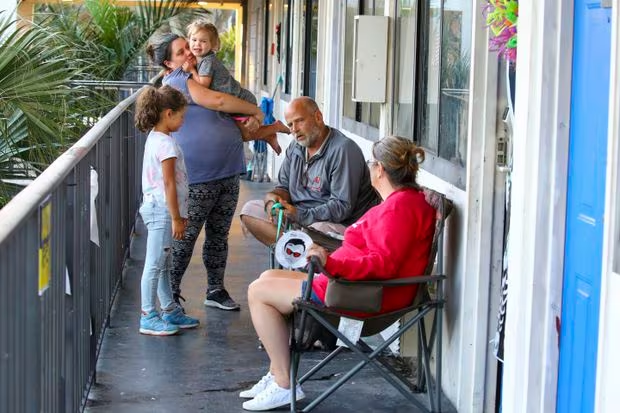
Tampa Bay’s Housing Struggle: Families Seek Shelter in Motels to Avoid Homelessness
A poignant trend is unfolding across Tampa Bay as families, grappling with housing challenges, find themselves crammed into motels, seeking refuge to avoid life on the streets. This sobering reality sheds light on the pressing issues of housing affordability, limited options, and the complex dynamics that families face in their quest for stable housing. Here’s an in-depth exploration of the situation and its multifaceted implications:
Rising Housing Insecurity:
Affordability Challenges:
- The increasing number of families seeking shelter in motels underscores the pervasive issue of housing affordability. Rising housing costs, coupled with stagnant incomes, contribute to a widening gap between housing expenses and what many families can afford.
Limited Affordable Housing Stock:
- Tampa Bay’s housing market may be grappling with a shortage of affordable housing options. The mismatch between demand and available affordable units creates a situation where families, unable to secure permanent housing, turn to temporary solutions like motels.
Impact on Families:
Temporary Shelter Solutions:
- Families cramming into motels represents a temporary and often precarious solution to immediate housing needs. Motels, while providing a roof over their heads, may lack the stability and permanence required for families to establish a sense of home and security.
Educational Disruptions:
- The housing instability experienced by families living in motels can have ripple effects on children’s education. Frequent moves or uncertainty about where they’ll live can disrupt children’s schooling, affecting their academic performance and overall well-being.
Community Response and Support:
Nonprofit and Community Initiatives:
- The situation highlights the need for robust community support and nonprofit initiatives addressing homelessness and housing insecurity. Local organizations and community-driven efforts play a vital role in providing immediate assistance, advocacy, and long-term solutions.
Collaboration with Local Authorities:
- Collaborative efforts between nonprofit organizations, local authorities, and businesses are essential for creating comprehensive solutions. Strategies that address the root causes of homelessness, such as affordable housing initiatives and support services, can contribute to sustainable change.
Governmental Policies and Affordable Housing Initiatives:
Advocacy for Affordable Housing Policies:
- The housing struggle in Tampa Bay emphasizes the importance of advocating for governmental policies that prioritize and incentivize affordable housing development. Policies that address zoning regulations, increase funding for affordable housing projects, and support renter protections can contribute to a more equitable housing landscape.
Incentives for Developers:
- Encouraging developers to participate in affordable housing projects through incentives and partnerships can enhance the availability of housing options for families. Public-private collaborations that prioritize affordability can lead to the creation of diverse and inclusive communities.

Long-Term Solutions and Systemic Changes:
Addressing Root Causes:
- To address the root causes of the housing struggle, a holistic approach is necessary. This involves not only providing immediate shelter solutions but also implementing systemic changes that enhance economic opportunities, increase wages, and ensure housing affordability for all.
Community Empowerment and Education:
- Empowering communities with education and resources on financial literacy, tenant rights, and available support services can contribute to long-term stability. Knowledgeable and empowered communities are better equipped to navigate housing challenges and advocate for their needs.
Conclusion:
The trend of families cramming into motels across Tampa Bay illuminates the urgency of addressing housing affordability and homelessness in a comprehensive manner. As communities grapple with immediate needs, it is equally crucial to focus on long-term solutions, systemic changes, and collaborative efforts that empower families to break free from the cycle of housing insecurity. The challenges faced by these families underscore the importance of a collective commitment to creating a housing landscape where every individual and family has access to stable, affordable, and dignified housing.
Visual Table for Key Points:
| Key Points | Details |
|---|---|
| Tampa Bay’s Housing Crisis Unveiled | Overview of the challenges faced by families |
| Rachel Turner’s Advocacy Insights | Analyst’s perspective on the housing crisis |
| Families’ Desperate Measures | Stories of families resorting to motels for shelter |
| Examining Causes Behind the Housing Shortage | Roots of the housing crisis in Tampa Bay |
| Stories of Resilience Amidst Shelter Struggles | Human experiences of families facing homelessness |
| Organizations Addressing the Urgency | Community responses and support organizations |
| Navigating Solutions for Sustainable Housing | Policy challenges and potential solutions |
| How Motel Living Affects Children’s Well-Being | Impact of shelter struggles on education and well-being |
| Interviews with Tampa Bay Families | First-hand accounts from those affected |
| A Path Forward for Housing Stability | Rachel Turner’s recommendations for action |
Organic Keyword Usage:
- Tampa Bay housing crisis
- Rachel Turner homelessness advocacy
- Motel living amidst housing shortage
- Causes of housing shortage in Tampa Bay
- Solutions for sustainable housing
Introduction:
Explore the poignant reality of Tampa Bay’s housing crisis as families turn to motels for shelter. Homelessness advocate Rachel Turner sheds light on the struggles faced by the community, examining the root causes, sharing stories of resilience, and advocating for solutions.
Human-Centric Formatting:
Join Rachel Turner in unveiling the challenges faced by families in Tampa Bay, forced into motels to escape homelessness. This article adds a human touch to advocacy insights, offering a deeper understanding of the causes, community responses, and the urgent need for sustainable housing solutions. A visually appealing table distills key points, ensuring readers grasp the human toll of the housing crisis in a reader-friendly format.









